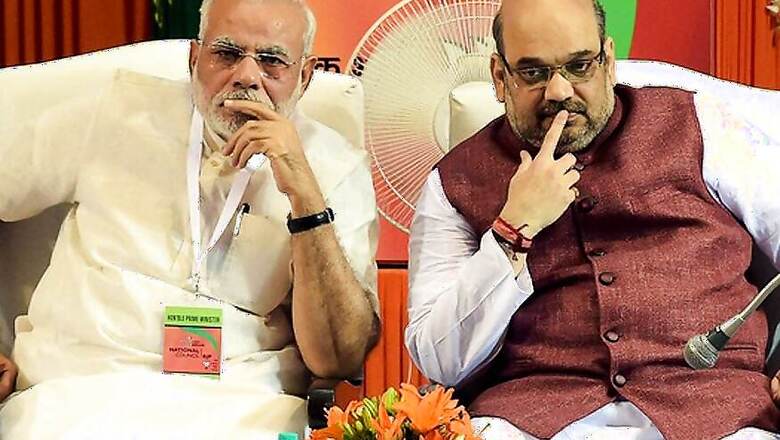
views
New Delhi: The Election Commission of India has announced the dates for the upcoming Lok Sabha polls. The elections will be held from April 11, 2019 in seven phases. While, the poll pundits are already out there with their bets, one overwhelming narrative is that the Bharatiya Janata Party (BJP) could be forming the government for the second consecutive term. However, it won’t be that easy.
In 2014, the BJP emerged with a majority and formed the government. In the state elections thereafter the BJP spread far and wide, forming governments in state after state. At one point—in 2017—the BJP ruled 19 states. However, in the last five years, the political graph of the country has changed. And at the receiving end of this has been the BJP.
The saffron party is now ruling in 15 states, either itself or in alliance with the NDA. In 2014, the party ruled in just seven states.
However, among the total 15 states that the BJP rules right now, it formed the government with its own capacity—surprisingly—in just five states. The rest 10 states, the BJP has an alliance with its allies. On the contrary, its main rival, the Congress, has a government on its own in four states.
On the other hand, before the 2014 elections, the Congress, either itself or in an alliance, held power in 14 states. That number has come down to six. But the recent wins in Rajasthan, Chhattisgarh and Madhya Pradesh have given the grand old party some confidence before the Lok Sabha polls.
The six states, however, where the Congress is in power sends 107 MPs—Punjab (13), Rajasthan (25), Madhya Pradesh (29), Chhattisgarh (11), Karnataka (28) and Puducherry (1)—to the Lok Sabha.
The total Lok Sabha seats in the BJP/NDA ruled fourteen states is 252.
But besides these, there are several figures that depict a curious picture of ongoing political war of retaining power for the BJP and the Congress’s final push ahead of the Lok Sabha polls.
Recent Setback to BJP in Hindi Belt
In the assembly elections held in Rajasthan, Madhya Pradesh, Chhattisgarh, Telangana and Mizoram, the Congress registered its remarkable comeback in three out of five states. The Congress wrested power from the ruling BJP in three major states of the Hindi heartland—Rajasthan, Madhya Pradesh and Chhattisgarh. Together these three states have a total of 65 Lok Sabha seats.
The BJP also received a major setback in March 2018 with losses in the by-elections held in UP Chief Minister Yogi Adityanath’s home turf of Gorakhpur and Deputy CM Keshav Prasad Maurya’s former seat of Phulpur in Allahabad.
The Hindi heartland headache for the BJP could worsen during the upcoming Lok Sabha polls given the coming together of Bahujan Samaj Party (BSP) and Samajwadi Party (SP). The two parties had a vote share more than that of the BJP in at least 41 Lok Sabha constituencies in the state during the 2014 polls.
Uttar Pradesh sends 80 MPs to the Lok Sabha.
Ups and Downs in Coalitions Governments of BJP
Andhra Pradesh (2 LS Seats)
After the bifurcation of Andhra Pradesh to form new state of Telangana in 2014, the state was allocated 175 seats and the remaining 119 seats have been allocated to the latter in their respective assemblies.
Later in 2014 state assembly elections, Telugu Desam Party (TDP) defeated previously ruling Congress and bagged 103 seats to form the government. Initially, the BJP was in the alliance with the TDP but it got spilt in March 2018.
Jammu & Kashmir (6 LS Seats)
In 87-member Assembly, a coalition government was formed between PDP with 28 seats and BJP with 25 seats after defeating the alliance of National Conference (15) and Congress (12) ruling earlier.
After three and half years, the coalition ended in 2018. The state is now under President Rule as the Governor rule ended in mid December 2018. In Jammu, from where the three BJP MPs won last time, the saffron party could face a stiff competition from the Congress and NC this time.
Punjab (13 LS seats)
Till 2017, BJP was a part of coalition government with Shiromani Akali Dal (SAD) but in the state elections the coalition lost to the Congress which bagged 77 seats in 117-member Assembly.
Bihar (40 LS Seats)
The state of Bihar having 243 seats Assembly seats, witnessed a very interesting regime shift when Janata Dal United (JD-U) head Nitish Kumar broke his party’s alliance with Lalu Prasad Yadav’s Rashtriya Janata Dal (JDU) in 2017. The new coalition government of the JD(U) came into existence with the BJP. Earlier, however, Nitish Kumar had been very critical of the BJP.
The current NDA government in Bihar consists of 70 JD(U), 53 BJP, 2 LJP and 4 Independent MLAs.
Drubbing in the By-polls
In last five years, of all the 30 LS seats that had by-polls since 2014, BJP slipped from 15 to 6 seats. The party has not gained wins in any new seats and has lost a total of 9 seats. While the Congress increased its tally from one to six, 18 candidates from other regional parties won these bypolls.
Out of the six seats that the BJP managed to hold, two wins came in 2014, and the other two other came in 2016. In 2015 and 2017 and till March 2018, the BJP did not win a single LS by-poll. Though in 2018, the party succeeded in retaining its 2 seats from Palghar (Maharashtra) and Shimoga (Karnataka) constituencies.
In contrast, the Congress won six of these Lok Sabha by-poll battles. Of these six seats, the Congress retained the Amritsar Lok Sabha seat and wrested the other five from the BJP’s kitty.
The major setback for the BJP in bypolls were observed in Ratlam, Gurudaspur, Ajmer, Kairana and Gorakhpur, Phulpur, Alwar, Bhandara-Gondiya and Bellary.
The North East Conundrum (LS 25 seats)
The fact that the BJP is hoping to make electoral gains in the Northeastern regions of the country in the upcoming Lok Sabha elections is known to all. The main reason for such a move is that the party is expected to face major losses in the ‘Hindi heartland’ states, which it had swept in 2014. To compensate for these losses, the BJP’s look east policy has gone through an interesting phase—they once struggled in these states but now have comfortably wrested power from the earlier governments in Assam, Tripura, Arunachal Pradesh and Manipur. Meanwhile in Meghalaya and Nagaland, the BJP is part of the government through an alliance with National People’s Party (NPP) and National Democratic Progressive Party (NDPP), respectively. In Mizoram and Sikkim, while BJP is not part of the ruling governments, the ruling parties are part of the NEDA that supports NDA at the Centre.
Keeping in mind the importance of these seats, Prime Minister Narendra Modi doesn’t want to let the northeast slip out of his hand. His frequency of visits to the eight states indicates his intent. While former PM Manmohan Singh has travelled to these states 38 times in his two terms, Modi has already made 30 visits before completing even one tenure.
The North eastern region regions of the country send 25 MPs to the Lok Sabha—Tripura (2), Assam (14), Arunachal Pradesh (2), Nagaland (1), Manipur (2), Meghalaya (2), Mizoram (1) and Sikkim (1). The results of the assembly elections held in last five years proved that BJP certainly got an edge in the region after forming government—itself or with an alliance—in six out of eight states.
But the things have changed now. The BJP will have to battle several factors in the run up to the upcoming Lok Sabha elections: from anti-beef sentiments for the Christian majority states like Mizoram and Nagaland—which has been although sidelined here—to the failure in freeing the region from several insurgent groups. What might have recently added to the turmoil are the latency in rescuing the miners in Meghalaya and the uproar on the Permanent Residence Certificates in the Arunachal for the Assam tribals. And last but not the least, the elephant in the room—the Citizenship Amendment Bill in Assam and Nagaland. Meanwhile, the support factions from other two states, IPFT in Tripura and MNF in Mizoram, have already shown their resentment against the Bill.
Grand Opposition Alliance and the UPA
However, the biggest threat that the BJP is facing is its alliances have significantly weaned away from the party.
Over various issues, a total of 15 parties have quit the NDA. They include: Haryana Janhit Congress, Marumalarchi Dravida Munnetra Kazhagam (MDMK), Desiya Murpokku Dravida Kazhagam (DMDK) , Jana Sena Party, Revolutionary Socialist Party (Bolshevik), Janadhipathya Rashtriya Sabha, Swabhimani Paksha and Asom Gana Parishad (AGP).
The BJP still has support of around 40 regional parties under the NDA. On the other hand, over 20 parties support Congress as a part of UPA.
A grand rally held in January this year in Kolkata showed the emergence of “Grand Opposition Alliance” (Mahagathbandhan) in which national leaders of more than 20 national and regional parties, including Congress, Trinamool Congress, TDP, BSP, SP, NC, RJD and LJD, threw new challenge for the BJP/NDA.




















Comments
0 comment